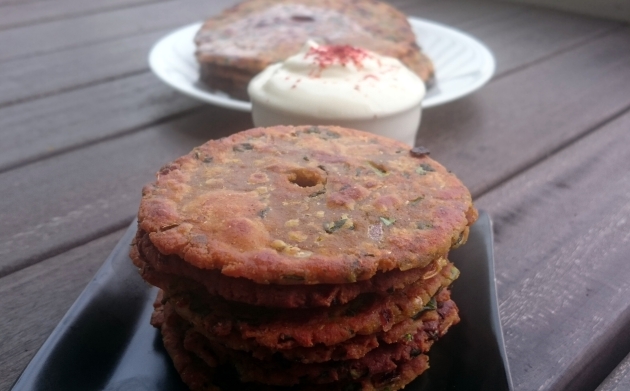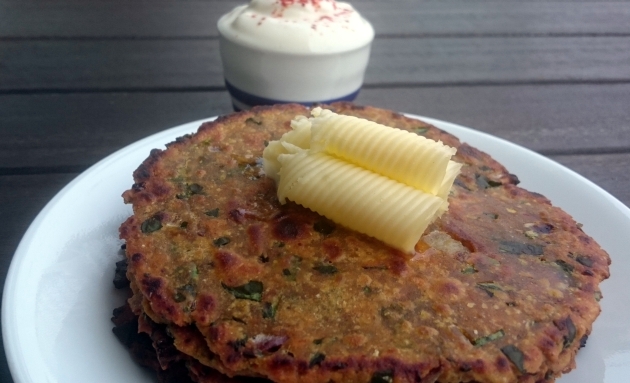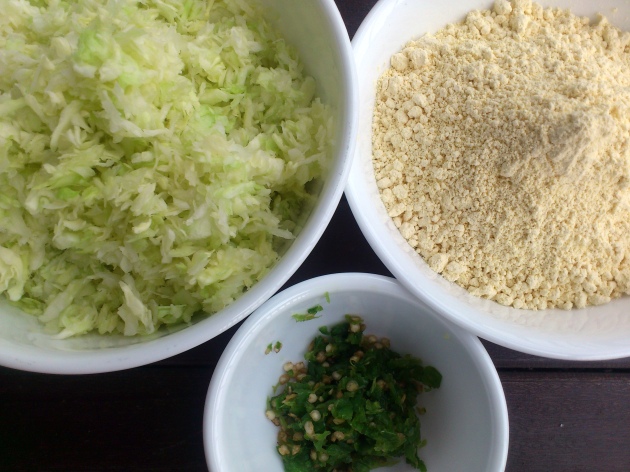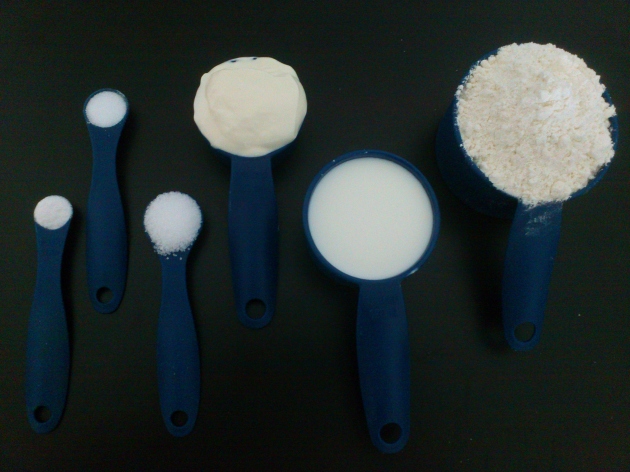Thalipeeth is a Maharashtrian breakfast or tea time snack. It is a very nutritious dish made with seven types of flours and fresh vegetables. Thalipeeth is usually served with fresh homemade butter, ghee, or thick yogurt. The recipe varies from region to region or even family to family and this is the recipe I have eaten. The flour for thalipeeth is called Bhajni. It is a mix of various flours. Even this differs from family to family. Some people add ragi and semolina while some leave out the bajra flour. I use the store bought bhajni flour which is easily available.

Even with the other ingredients, it differs from home to home. Traditionally it is just onions but you can add chopped spinach, chopped methi leaves, grated carrots or grated cabbage too. You can also add sesame seeds or coarsely ground peanuts. Rolling the thalipeeth can be a task. Since the dough has bajra flour and besan in it, it is not easy to roll with a rolling pin. If you cannot shape it with your palm like bajra rotis, you can put it between sheets of greased plastic and roll it. I used two sheets of butter paper and did not have to use the extra oil for greasing.

Thalipeeth is thicker than roti. Making holes in the thalipeeth and cooking it covered helps it to cook evenly. Thalipeeth is best eaten hot with homemade butter, ghee, or thick yogurt. I like it with garlic chutney and yogurt.

Ingredients
Makes 12 Thalipeeths
- 3 cups Thalipeeth Bhajani flour
- 1 onion finely chopped
- 1 green chilli finely chopped
- ¼ cup chopped coriander leaves
- 1 cup chopped spinach
- 2 tsp red chili powder
- ¼ tsp turmeric powder
- Salt to taste
- Warm water for kneading the dough
- 1 tbsp oil
- oil for cooking
Recipe
Mix the thalipeeth flour, onions, spinach, chillies, coriander leaves, salt, red chili powder, turmeric powder, and oil. Add little warm water at a time and knead the mixture into stiff but pliable dough. Cover it and keep it aside for 5-10 minutes. Knead the dough again and divide it into number of thalipeeths you want to make. Roll each portion into circles. You can do this with your palms just like the like the bajra roti is made or place the dough ball in between two sheets of butter paper and roll it carefully. Make a small hole in the center of the thalipeeth. If you are making a big roti, bigger than 5 inches in diameter, you can make multiple holes. These holes are used to pour oil and cook the thalipeeth evenly.
Heat a tava and smear around 1/2 tsp oil on the tava. Peel the butter paper from the thalipeeth carefully and place the thalipeeth on the tava. Pour some oil in the holes and around the thalipeeth. Cover and cook for around two minutes on medium heat. Flip and cook for two more minute. Serve hot with homemade butter, yogurt, or garlic chutney.
Thalipeeth Bhajni
To make the Thalipeeth flour at home, roast the following flours separately on low heat for 8-10 mins making sure you do not burn any of them. Once the flours are roasted and cooled completely, mix them and store in airtight container. This thalipeeth flour can be stored for 4-5 months.
- 1 cup Bajra atta (Millet flour)
- 1/2 cup Chawal ka atta (rice flour)
- 1/2 cup Besan (split bengal gram flour)
- 1/2 cup Jowar aata (sorghum flour) 1/3 cup urad dal aata (split black gram flour)
- 1/2 cup gehu ka atta (wheat flour)
- 1/4 cup dhania powder (ground coriander seeds)


























